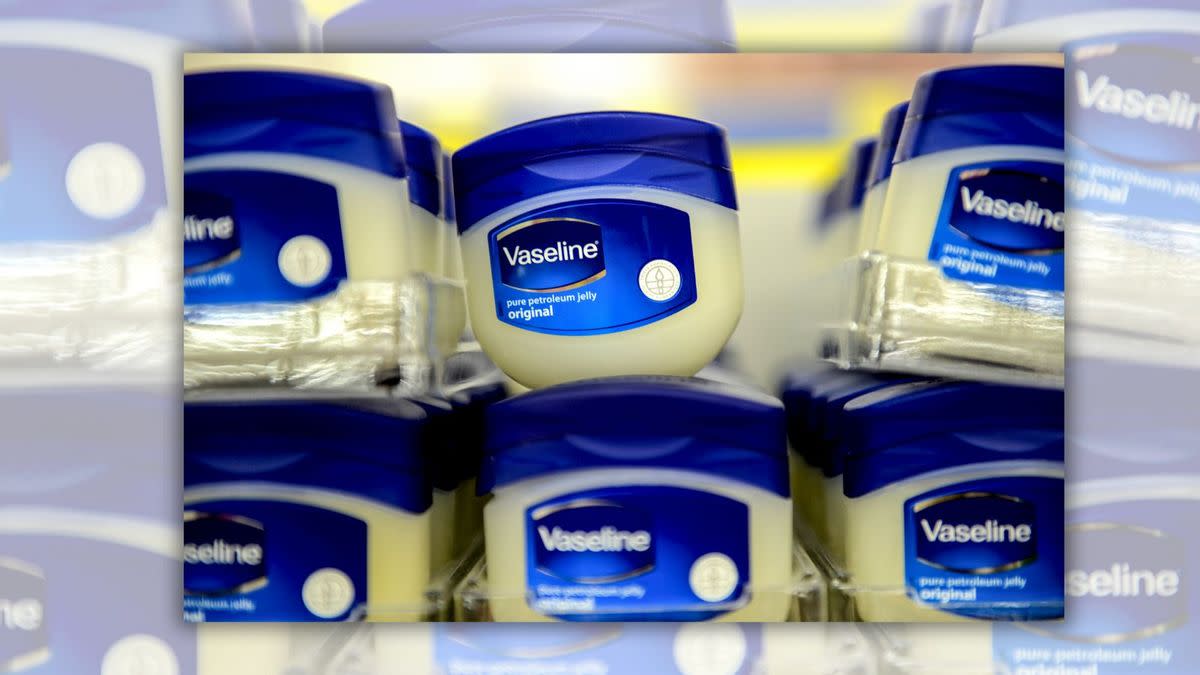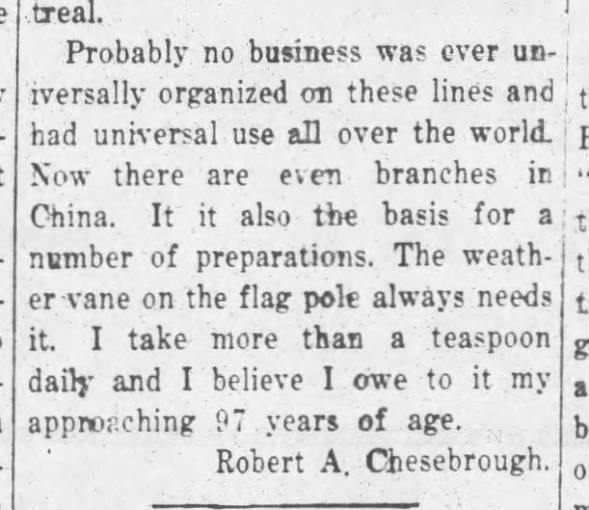Vaseline Inventor Ate Spoonful of Petroleum Jelly Every Day?

Claim:
Robert A. Chesebrough, the inventor of Vaseline, ate a spoonful of petroleum jelly every day until he died at age 96, and once cured himself of pleurisy by having a nurse cover his body in Vaseline.
Rating:
What's True:
Shortly before petroleum jelly inventor Chesebrough died in 1933, at the age of 96, he publicly claimed to ingest "more than a teaspoon" of Vaseline daily. However ...
What's Undetermined:
We were unable to confirm the claim that he once cured himself of a case of pleurisy by having a nurse cover his body in Vaseline.
On June 28, 2024, a Reddit user made a post on the r/Damnthatsinteresting subreddit claiming that the inventor of Vaseline, Robert A. Chesebrough, ate a spoonful of petroleum jelly every day until he died at age 96 and once cured himself of pleurisy, an inflammatory condition of the tissues that line the lungs and chest cavity, by having a nurse cover his body in Vaseline.
https://www.reddit.com/r/Damnthatsinteresting/comments/1dqie0d/the_inventor_of_vaseline_robert_chesebrough_was/
The post had received around 68,000 upvotes and 2,000 comments at the time of this writing.
Several hours after the r/Damnthatsinteresting post appeared, the same claims were repeated in a similar post by X user @historyinmemes. That post had been liked around 23,000 times and reposted around 3,800 times as of this writing.
Snopes was able to confirm the first part of the claim thanks to a letter he wrote to the Spring Lake (New Jersey) Gazette six months before his death. In it, Chesebrough, then 96, indeed attributed his longevity to eating "more than a teaspoon daily" of Vaseline. The relevant section of the letter can be seen in the Newspapers.com clip below.
March 2, 1933, Spring Lake Gazette (Spring Lake, New Jersey) Newspapers.com
Although the part of the claim that concerns Chesebrough's daily ingestion of Vaseline is true, we have so far been unable to locate any primary or authoritative secondary sources corroborating the part of claim concerning Chesebrough allegedly treating a case of pleurisy by having a nurse cover his body in petroleum jelly. For this reason, we rate the claim as "Mixture." We will update our rating if strong evidence for this second part of the claim surfaces.
Tracing the Claims
As outlined on the official Vaseline website's "Our History" page, Chesebrough developed the idea for petroleum jelly, the generic name for the substance later marketed as Vaseline, when oil drilling began in Titusville, Pennsylvania, in 1859. A chemist with previous experience producing kerosene from whale oil, Chesebrough took special interest in a byproduct of petroleum called rod wax, which Titusville oil workers had begun using as a salve for cuts and burns.
In 1865, Chesebrough filed the first of several patents for methods for purifying petroleum into petroleum jelly, which he began selling under the brand name Vaseline in 1870.
The earliest publication to contain the full claim investigated here was an article titled "Mr. Chesebrough's Wonder Jelly," which was published in Coronet magazine in November 1953. Without any mention of how he found this information, the article's author, Mort Weisinger, wrote,
So great a faith did Robert Chesebrough have in the therapeutic value of his product that he swallowed a spoonful every day of his life ... In his late fifties, ill with pleurisy, he made his nurse anoint him with the substance from head to toe — and promptly recovered. Chesebrough died in 1933 at 96. On his deathbed, he boasted that he owed his longevity to his habit of taking a daily dose of the jelly.
Over the following decades, these claims appeared in whole or in part in popular books, newspaper articles, blog posts, in "Ripley's Believe it or Not," and even on the Britannica website. However, none of these appearances pointed readers toward an authoritative or primary source for the claim.
This was the case even for a mention of the claim that appeared in a 2017 issue of JAMA Dermatology, an academic journal published by the American Medical Association. In their citation for the claim, the authors of the piece pointed toward "Panati's Extraordinary Origins of Ordinary Things," a book first published in 1987, which does include the claim but provides no source for it in the "References" section at the end of the book.
Snopes was able to track down the newspaper article verifying the part of the claim concerning Chesebrough's daily consumption of Vaseline by scouring obituaries published after the inventor died in September 1933. One obituary, published in the Spring Lake Gazette, noted that Chesebrough, a Spring Lake resident at the time of his death, had "frequently" contributed articles and letters to that paper.
A survey of Chesebrough's contributions to the Spring Lake Gazette turned up the aforementioned March 2, 1933, letter in which Chesebrough both described his daily Vaseline ingestion and explicitly claimed he believed it was the source of his longevity. Chesebrough died in September of the same year, several months after the letter was published.
None of Chesebrough's letters to this publication contained any mention of Chesebrough curing himself from an attack of pleurisy by having a nurse slather him in petroleum jelly, and as of this writing we have not been able to locate any other sources published during or soon after Chesebrough's lifetime that might corroborate this part of the claim. For this reason, we have rated the overall claim as it is presented in social media posts as "Mixture."
Sources:
"150 Years of Vaseline® History." Vaseline, https://www.vaseline.com/in/en/who-we-are/our-history.html. Accessed 1 July 2024.
Gray, Christopher. "Streetscapes/The Chesebrough House, 71st Street and Madison Avenue; 1911 Home Built by the Man Who Invented Vaseline." The New York Times, 12 Oct. 2003. NYTimes.com, https://www.nytimes.com/2003/10/12/realestate/streetscapes-chesebrough-house-71st-street-madison-avenue-1911-home-built-man.html.
Jayakumar, Kishore L., and Robert G. Micheletti. "Robert Chesebrough and the Dermatologic Wonder of Petroleum Jelly." JAMA Dermatology, vol. 153, no. 11, Nov. 2017, p. 1157. Silverchair, https://doi.org/10.1001/jamadermatol.2017.3544.
One Good Fact about Eating Vaseline | Britannica. https://www.britannica.com/one-good-fact/what-petroleum-product-was-regularly-eaten-by-its-creator. Accessed 1 July 2024.
Panati, Charles. Panati's Extraordinary Origins of Everyday Things. Book Sales, 2016.
Search | Ripley's Believe It or Not! | Aquariums, Attractions, Museums. https://www.ripleys.com/search?q=chesebrough. Accessed 1 July 2024.
"Spring Lake Gazette Archive." Newspapers.Com, 2 Mar. 1933, https://www.newspapers.com/paper/spring-lake-gazette/11695/.
"Story of Vaseline." Damn Interesting, https://www.damninteresting.com/curio/story-of-vaseline/. Accessed 1 July 2024.
Weisinger, Mort. "Mr. Chesebrough's Wonder Jelly." Coronet 1953-11: Vol 35 Iss 1. Hearst Brand Development, 1953. Internet Archive, http://archive.org/details/sim_coronet_1953-11_35_1_0.
Wiegand, Steve. U.S. History For Dummies. John Wiley & Sons, 2009.

 Yahoo News
Yahoo News 


